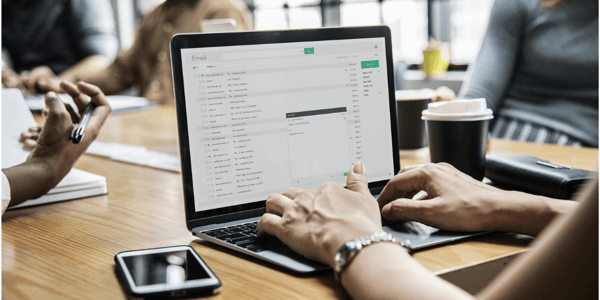The bar has been raised.
Like everything else in digital marketing, the sheer volume of participants has increased the need for high-value content. It's touched every avenue of marketing, and it's why you need to be optimizing your email campaigns.
Creating emails that earn the engagement you're after can be easier if you approach it with these 11 techniques.
Optimizing Email Campaigns for Insane Conversion Rates
The first thing you need to do for the highest conversion rates you've ever seen is have a plan to test everything. This is so important that every technique and tip we're about to list would include some aspect of testing.
Test religiously, and execute these optimization techniques for the email engagement you're after.
1. Ensure Your Service Provider is the Best Fit
Countless email providers are offering their services and most have features and benefits unique to them. Whether it's the low price point, a user-friendly interface, or improved data tracking, identifying you have the right email service provider for your business is critical.
Ensure you're able to manage your email lists in a manner that meets your needs. Some providers aren't as simple when it comes to segmenting your users. Others offer access to landing page tools and popups to increase your email list.
The main things you'll want to look for are how well they provide trigger-based delivery, workflows, and data collection. As the mobile market continues to grow, it's also paramount that they're able to display emails correctly on phones.
Companies like MailChimp and AWeber are well-reviewed and provide a range of services to hit any list size and target price you're looking for.
2. Pick the Right Sender
The first thing a person looks at when an email hits their inbox is who sent it.
It's the same thing that their email client looks at when deciding whether to mark something as spam or let it in.
Send emails from a real person. Avoid "info@yoursite.com." These emails have the highest risk of being marked as spam. They're also more likely to be ignored by the recipient.
Sending an email with the name of an actual person builds trust in your company. Include a signature with each email that's specific to the sender. If you can add a photo, that's even better. Prove that you're trying to connect with them on a personal level.
You should also vary who the emails are coming from. An email from your CEO may carry more weight than someone on the marketing team. Use that to your advantage with high-priority emails.
3. Segment Lists into Smaller Groups
The internet is continually becoming more personalized. Google is altering search results based on the intent of the specific person sending it.
There's a reason for it. Personalization is becoming expected in email marketing campaigns. It lets you send a message that's more relevant, increasing the odds of both parties being satisfied with the interaction.
Use your customer's behavior and engagement to split them into more refined segments. Find data like the pages they've viewed, products they've bought, the location they're from, and the company they work for. Any information you have could make it easier to provide more relevant content to the consumer.
While you're scrubbing your lists and breaking them into tighter segments, keep an eye out for those who aren't engaging. Send them a separate email, politely notifying them they'll be dropped off your list since they don't appear to need your emails. This will help keep your data accurate, so you can judge your actual engagement rates.
4. Improve Your Subject Lines
After seeing who the message is from, the recipient will look at the subject of the email. Just like with headlines, more people will see the subject than actually open the message, so it's essential to make it compelling.
Humanizing yourself is the name of the game. In fact, emails with personalized subject lines have 26% higher open rates than others. This doesn't need to include a name or some creepy tidbit of info you found. Mentioning the recent purchase of a product could be enough to earn the open.
Depending on your brand, you could also change the pace on your textual subject lines by adding emojis. 56% of brands using emojis in their subject earned higher open rates. Still, they're not for everyone.
However you choose to humanize your brand with email subject lines, make sure to provide on the promise they're opening for. While teasing the content is fine, misleading the recipient isn't.
5. Write Compelling Preview Text
Most email client displays will show 35-90 characters in the preview pane. That's not a lot of words to convince someone to open your message.
It's critical to provide a hook within the initial portion of your email to ensure it's displayed. Humor and questions are excellent approaches to quick engagement. The default text of "Having trouble viewing this email" is not.
You can use your preview text to build more interest in your subject line, but don't rely on it. Some clients won't show the text which could make your subject weaker.
As they start reading, build a sense of urgency that forces them to open the email after an ellipsis cuts off the text.
6. Make the Message Personal
Some data suggests that using names may hurt click-through-rates. Others have found it's a more effective technique to humanizing the brand. Ultimately, it comes down to what your audience thinks.
Mass marketing doesn't work the way it used to. People are expecting content that's relevant specifically to them. This is one of the key concepts of customer-centric marketing.
This is where your data from the segmented lists comes in handy. Use whatever you have to provide content and information that appeals to that customer as an individual.
When addressing the benefits of your products in an email, look at the recipient's background you've collected. Focus the benefits you're highlighting on ones that will speak best to them.
When writing the email, imagine you're telling a story to a friend. This has more and less effect depending on the brand, but it's a great technique for ensuring you're talking to them like a person, not a customer.
7. Use Visuals Appropriately
Visual marketing is becoming more widely spread as people have less time throughout the day. It's a way for marketers to get a point across faster. In fact, the human brain processes images 60,000 times faster than it does text.
The key is using images that are relevant and add to the email. If you're offering an eBook, provide a picture of one. If you're having a sale on shirts, add a picture of the line.
You should compress photos before sending and avoid using high res photos that will slow the load time.
While visuals can be effective, not using them can be a great tool to make your emails look more personal. It'll cause your email to appear more like it's sent from a person than as a marketing pitch.
8. Fine-Tune Your CTAs
When you start writing your email, focus on one specific action you want the reader to take. This is your call to action (CTA), and it's pivotal to improving your email conversions.
Create CTAs that are specifically designed for your emails and ensure they're optimized for mobile. They need to be eye-catching and use language the consumer would (think "download now" vs. "join us").
You also don't need to leave all the responsibility hanging on a single CTA. There's no reason you can't include links throughout the email unless it's too short to add them contextually.
9. Provide Social Sharing Options
Every email should give readers the chance to share on any social platform they prefer. It doesn't matter if you don't have a significant presence on it, so long as your gaining positive traction.
Make it easy to share by providing obvious social icons somewhere around the end of the message. You can also offer "lazy Tweets" if your audience frequents the platform.
Feel free to include copy asking for or recommending that they share the content. If you've built a brand that people want to support, they'll happily oblige.
If you're sending the emails from a real person, as you should, have them link the social accounts they're comfortable with. It further humanizes your brand and gives that personalized touch.
10. Make it Mobile-Friendly
As we mentioned before, many people will be reading your emails from their phone. It's imperative that they display correctly on mobile.
Select a font that's easy to read, but ensure it's available on all devices, otherwise you'll risk plaguing your customers with wingdings and the like.
Convert your email templates to one column so they fit comfortably on a mobile screen. Some providers will enable different templates of the same email based on how the provider opens it. If this is important to you, seek out that feature.
11. Play with Email Frequency
Email frequency will require more intuition and actual testing than the others to get right. Too many emails make them predictable and annoying. Too few makes your brand forgettable.
You can use data to get an idea of how many opens you're receiving with different send rates. Vary the rate for different segments as necessary.
How to Put It All Together
You probably noticed a theme of personalizing content. It's necessary to earning the conversion rates you're set. So long as you remember to A/B test everything and follow these techniques, we're sure you'll see positive results.
If you need more ideas for what to send in your email campaigns, consider repurposing content. In our free Content Repurposing Toolkit, we'll guide you through how to do it, so you're not wasting time, recreating the wheel.





